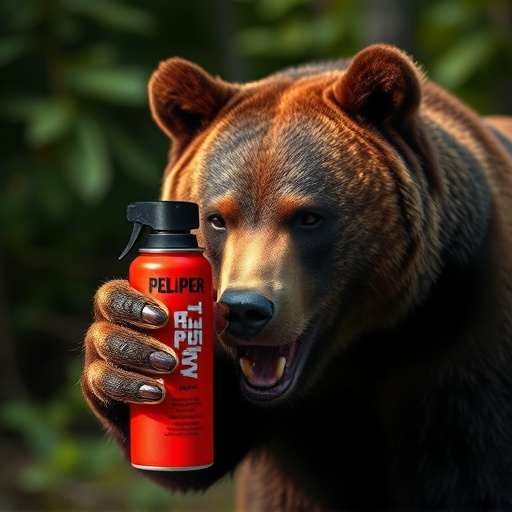Bear spray, with capsaicin-based formulations, offers superior protection against aggressive bears in wet environments compared to water. It irritates bears' eyes and respiratory systems, providing non-lethal yet potent deterrence even after runoff. Effective use techniques include direct application to faces and eyes, avoiding heavy rain, and using low-humidity times. Responsible spraying practices, like targeted applications and proper storage, ensure its safety for both users and aquatic life in water-prone areas.
“Enhance your wilderness survival kit with a powerful defense against aggressive bears: bear spray. This article delves into the maximum stopping power of bear spray, dissecting its effectiveness compared to water. We explore optimal application techniques in wet environments and crucial safety considerations for areas prone to runoff water. Discover best practices to ensure your safety while navigating bear country, making every moment count.”
- Understanding Bear Spray: What It Is and How It Works
- Bear Spray vs. Water: Comparing Effectiveness for Maximum Stopping Power
- Optimal Application Techniques for Bear Spray in Wet Environments
- Safety Considerations and Best Practices for Using Bear Spray in Water-Prone Areas
Understanding Bear Spray: What It Is and How It Works
Bear spray, also known as bear repellent, is a powerful defense mechanism designed to protect individuals from aggressive bears in their natural habitats. It’s more than just a spray; it’s a specialized formulation that combines capsaicin (the active ingredient found in chili peppers) with other chemicals to create an effective barrier against bears. When used correctly, bear spray can provide valuable time and distance for people to escape potential bear encounters in backcountry areas.
The unique aspect of bear spray is its ability to deter bears even in water. Unlike traditional sprays that might be ineffective after coming into contact with runoff water, bear spray remains potent when exposed to moisture due to its special formulation. This makes it a preferred choice for outdoor enthusiasts navigating through wet environments or those who encounter bears near rivers and streams. Understanding how bear spray works, especially its resistance to water, is crucial for ensuring maximum safety during potential bear encounters in various settings.
Bear Spray vs. Water: Comparing Effectiveness for Maximum Stopping Power
When it comes to maximum stopping power for bear defense, a common debate arises between bear spray and water. Both are designed to deter aggressive bears, but their effectiveness differs significantly. Bear spray, also known as bear repellent, is specifically formulated to irritate a bear’s eyes and respiratory system, causing them to retreat. It offers a non-lethal solution that can provide crucial time for escape or assistance in potentially dangerous situations.
On the other hand, water itself may not be as effective as bear spray when it comes to water safety and stopping power. While a good spray of water might momentarily startle a bear, it won’t leave a lasting impact like bear spray. The key ingredient in bear spray—capric acid or oleoresin—is known for its potent effects on bears, making it a more reliable choice for maximum protection in grizzly country. Bear spray runoff is designed to linger and stick to the bear’s fur, ensuring continued irritation even after the initial spray, which can be the difference between safety and a dangerous encounter.
Optimal Application Techniques for Bear Spray in Wet Environments
In wet environments, proper application techniques for bear spray are crucial for maximizing its stopping power. When dealing with runoff water, ensure the spray reaches the bear’s face and eyes directly. Aim for close proximity, as droplets can quickly evaporate in moist air, reducing the effectiveness of the spray. Techniques such as a quick, sharp burst at close range or a sweeping motion across the bear’s face can help overcome the spray’s tendency to disperse faster in wet conditions.
Bear spray safety extends beyond application. Understanding that runoff water can dilute the spray’s potency, it’s essential to be mindful of the surrounding environment. Avoid spraying in heavy rain or near large bodies of water, as this may lessen the impact. Instead, opt for early morning or late evening applications when humidity levels are lower, ensuring better retention of the spray on the bear’s fur and increasing the chances of a successful deterrence.
Safety Considerations and Best Practices for Using Bear Spray in Water-Prone Areas
When using bear spray in water-prone areas, safety considerations and best practices are paramount to ensure effectiveness and prevent environmental harm. It’s crucial to understand that bear spray runoff can impact nearby water bodies, potentially affecting aquatic life and ecosystems. Therefore, users must apply it responsibly, aiming for targeted use rather than spraying excessively into rivers, lakes, or streams. Proper application technique includes holding the canister upright, using short bursts, and avoiding wind to minimize spray drift.
Additionally, selecting bear spray designed for water-resistant or waterproof performance is recommended to maintain its stopping power in wet conditions. Users should also be mindful of their surroundings, staying alert for any signs of bear activity and being prepared to retreat if necessary. Regularly checking expiration dates and storing bear spray properly in dry, cool locations further ensures optimal performance when needed. Prioritizing water safety and responsible usage goes hand-in-hand with maximizing the defensive capabilities of bear spray in these environments.
Bear spray remains a powerful defense against bear encounters, especially in wet environments. While water can reduce its effectiveness, proper application techniques and understanding of runoff dynamics ensure optimal protection. Always prioritize safety by following best practices tailored for water-prone areas, ensuring bear spray continues to serve as a reliable tool for protecting both individuals and communities from potential bear threats.
